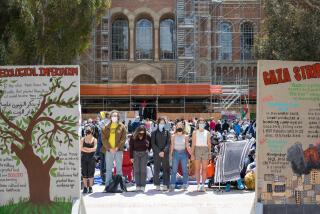In graphic protest
The imbecilic plan for war with Iraq currently on offer from the Bush administration has yet to register much support from the American public. A Los Angeles Times poll last month showed 72% of respondents -- including 60% of Republicans -- saying the president has not provided enough evidence to justify starting a war against Saddam Hussein.
Notably, however, the absence of public support for Bush’s war is not the same thing as active opposition to it. Only recently has an energetic movement against the proposed war begun to stir.
The reason is simple. President Bush keeps shifting his explanations for invading Iraq; yet, even minus a coherent argument, he seems prepared to proceed without a public mandate. Fear begets action.
At Track 16 Gallery, “The Anti-War Show: The Price of Intervention From Korea to Iraq” is a provocative historical exhibition that surveys antiwar agitprop during the last half-century, while tacitly participating in today’s budding movement. On view are nearly 120 posters from the past 50 years, all made in ardent opposition to a wide array of American involvements in foreign military escapades
Some, like Vietnam, are familiar periods of antiwar fervor. Others, like regular episodes of U.S. support for brutal regimes in Central and South America and in Africa, are less directly antiwar than they are anti-covert (or overt) support in other nations’ conflicts. Some declare more general political principles.
The show is organized by global region. It begins with Asia and ends in the Middle East. The best of these posters are, like all good agitprop, graphically simple, linguistically blunt and conceptually resonant.
The most recent poster is so new the ink might still be wet -- a glossy poster signed by “O” and dated 2003. Thirteen nested American flags, amplifying a famous painting by Jasper Johns, together create a jazzy, patriotic field for the printed word “democracy.” Each letter is composed from a fragment of an immediately recognizable com- mercial logo, starting with Disney and Enron and concluding with CNN and Yahoo. A government in which corporations hold the ruling power, rather than the people, is asserted with terse visual wit.
Individual artists or collectives have signed some posters, but many are anonymous. Since political posters are meant to be seen as a voice of the people, acting as citizens, names are generally superfluous.
The most famous work here bears the legend “War is not healthy for children and other living things.” It’s entwined around the thick stem and branching leaves of a stylized sunflower.
The message, dating from the Vietnam era, is not specific to that conflict, but the flower-power icon, printed in black ink against a vivid yellow ground, partakes of a popular visual cue of the moment. Published in Beverly Hills by Another Mother for Peace, the image was up to the minute.
It also cleverly recalls the age-old visual archetype of “the tree of life.” Many of the strongest posters engage in this sort of creative adaptation, where the passing issue of the day is inscribed within an established, widely celebrated tradition. The device lends gravity.
A blistering image by Tomi Ungerer, for example, steps back from the awful carnage of Korea, Vietnam and Cambodia to question a larger principle. An arm emblazoned with the word “EAT” is shown shoving the Statue of Liberty down the throat of a cringing yellow face. Force-feeding democracy into Communist Southeast Asia is succinctly identified as a Cold War engine of deadly violence.
Formally, the poster also resonates on another level. The shrieking, tossed-back yellow head summons to mind Picasso’s “Guernica,” the most celebrated antiwar image of the 20th century. “Guernica” was painted by an artist who joined the Communist Party soon after. Subliminal punch is added to Ungerer’s otherwise visceral drawing.
Often these antiwar posters engage in hyperbole, the better to attract attention. Frequently they feature images that are frightening, gruesome or sentimental, designed to tug at heartstrings. Emotional immediacy is prized as a visual weapon. They mean to shake up viewers.
Do posters actually incite audiences to take political action? Perhaps some do.
First and foremost, though, they function as a kind of social solace.
Antiwar posters are not unlike the American flags that proliferated in the fearful weeks after Sept. 11. Some of those flags were raised as strutting assertions of jingoist bluster, but I’d wager most were not. Flags erupted instead as a sign of collectivity during a moment of awful darkness -- a public assertion that one in fact was not alone. Antiwar posters do the same.
The Track 16 show was organized by Carol Wells, executive director of the Center for the Study of Political Graphics, and it’s drawn almost entirely from the center’s enormous collection of some 50,000 items. Partly it’s an updated reprise of an exhibition that was mounted in December 1990. Then, the impending war was also against Iraq, and the presidential warrior was also named Bush.
One big difference between 1990 and 2003 is the pervasiveness today of the Internet, with its power as a tool of dissemination. The digital ether meets the printing press at the intersection of posters and the Web, a juncture seen in two works showing a nuclear explosion above the captions “Bush’s Foreign Policy” and “Bush’s Domestic Policy.” Below the captions these posters advertise a Web site -- www. savethefuture.org -- where you can freely download the very poster you are looking at. The Internet, originally conceived by the U.S. Defense Department, gets used as an instrument of democracy.
*
‘Anti-War Show’
What: “The Anti-War Show: The Price of Intervention From Korea to Iraq”
Where: Track 16 Gallery, Bergamot Station, 2525 Michigan Ave., Santa Monica
When: Closed Sunday and Monday
Ends: Feb. 15
Price: Free
More to Read
The biggest entertainment stories
Get our big stories about Hollywood, film, television, music, arts, culture and more right in your inbox as soon as they publish.
You may occasionally receive promotional content from the Los Angeles Times.











